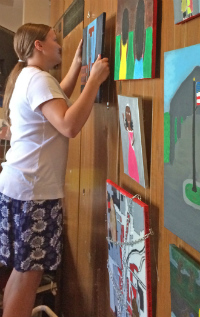Ruby Jazwinski said she enjoyed talking with ArtPrize-goers about the paintings and digital images she and a group of district middle schoolers created about a Grand Rapids neighborhood that represents a turn in local race relations.
“It’s good for people to learn about, and to remember it, so it doesn’t come back,” explained the Northern Middle eighth-grader. “A lot of people in my classes — my friends — are all different races. I don’t want to have to go through that.”
Exhibited at Fountain Street Church during the 8th annual international art competition, the “Auburn Hills Project” — # 62715 — depicts in images what students learned last year from three former residents of the first Grand Rapids neighborhood to break the housing color barrier.
The ArtPrize entry was the culmination of a multi-school design-think project aimed at getting nearly 80 students in the district to use the visual arts to promote the legacy of the neighborhood.
“Even though segregation is not out in the open, it’s still everywhere,” said eighth-grader Jenna Mustapha last year. “This was so close to where we live. It’s hard to imagine what they had to put up with.”
Edye Evans Hyde, Paula Triplett and Toni Spencer-Beatty spoke last school year to groups of students at Northern Middle. Triplett, whose family helped start the neighborhood, moved there when she was 5.
“All us kids in the neighborhood, we were community,” Triplett told the Forest Hills students. “It was a great experience, a great childhood, though I think our parents were afraid.”

A Brief History
In 1962, Paula Triplett’s father, Samuel Triplett, along with Joseph W. Lee, J. E. Adams and Dr. Julius Franks, made a bid to buy and develop a tract of land owned by the city of Grand Rapids, according to Grand Rapids Historical Society documents. They wanted to create a subdivision of 50 or 60 medium-priced homes on 20 acres, just southeast of the intersection of Fuller Avenue and Knapp Street NE.
The men were acting in response to “redlining,” a now illegal type of racially-motivated bank credit rationing that made it difficult or impossible to get a housing loan inside a specific redlined area. Eventually the city approved the sale and passed the Fair Housing Ordinance in December 1963. Today the neighborhood is home to about 740 people, according to the 2010 Census, mixed about 35 percent white, 52 percent black and 6 percent Hispanic, plus other nationalities.
Promoting the Legacy
The Northern Middle students’ ArtPrize work includes one group of paintings, each portraying an aspect of the development and early days of the Northeast side neighborhood. Additionally, two groups of students chose to use photographic collages depicting images and concepts related to the neighborhood.
As part of their projects, art teacher Diane Hartig required that their final product be a public presentation of some sort, related to promoting the legacy of the Auburn Hills neighborhood.
Three classes participated. One chose ArtPrize, and another displayed at the district’s annual Student Art Exhibit as a presentation to sixth-graders. The third chose the form of a book, a copy of which was presented by a few students to the last surviving founder of Auburn Hills, Jay Adams, during a special ceremony honoring him at the Grand Rapids Public Museum in June.
Fountain Street Church was specifically sought as an ArtPrize venue, Hartig explained, because of the church’s role in the establishment of Auburn Hills. The late Duncan Littlefair, the church’s pastor during the time of the controversy surrounding the sale of the land, was a vocal supporter and influential in turning things in favor of establishing the neighborhood, Hartig said.
“I loved what they came up with. All of the exhibits touched me,” Triplett said. “I was moved by several of the portraits, but to me, the real story is the narrative of why each student painted the picture they did. This is their response to racism.”
She urged young people to “always give your voice to what you see, learn and experience; your voice is important and relevant.”
CONNECT









